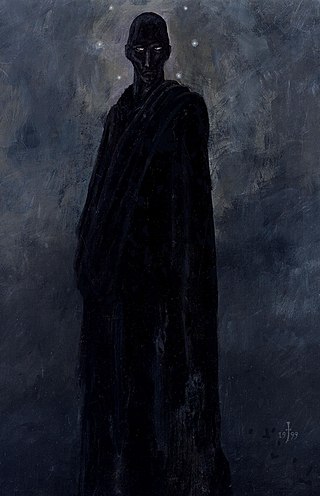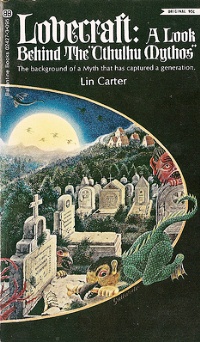Related Research Articles

The Cthulhu Mythos is a mythopoeia and a shared fictional universe, originating in the works of American horror writer H. P. Lovecraft. The term was coined by August Derleth, a contemporary correspondent and protégé of Lovecraft, to identify the settings, tropes, and lore that were employed by Lovecraft and his literary successors. The name "Cthulhu" derives from the central creature in Lovecraft's seminal short story "The Call of Cthulhu", first published in the pulp magazine Weird Tales in 1928.

The Necronomicon, also referred to as the Book of the Dead, or under a purported original Arabic title of Kitab al-Azif, is a fictional grimoire appearing in stories by the horror writer H. P. Lovecraft and his followers. It was first mentioned in Lovecraft's 1924 short story "The Hound", written in 1922, though its purported author, the "Mad Arab" Abdul Alhazred, had been quoted a year earlier in Lovecraft's "The Nameless City". Among other things, the work contains an account of the Old Ones, their history, and the means for summoning them.

Shub-Niggurath is a deity created by H. P. Lovecraft. She is often associated with the phrase "The Black Goat of the Woods with a Thousand Young". The only other name by which Lovecraft referred to her was "Lord of the Wood" in his story The Whisperer in Darkness.

Nyarlathotep is a fictional character created by H. P. Lovecraft. The character is a malign deity in the Cthulhu Mythos, a shared universe. First appearing in Lovecraft's 1920 prose poem "Nyarlathotep", he was later mentioned in other works by Lovecraft and by other writers. Later, writers describe him as one of the Outer Gods, an alien pantheon.

Azathoth is a deity in the Cthulhu Mythos and Dream Cycle stories of writer H. P. Lovecraft and other authors. He is the supreme deity of the Cthulu Mythos and the ruler of the Outer Gods, and may also be seen as a symbol for primordial chaos, therefore being the most powerful entity in the entirety of the Cthulhu Mythos.

Hastur is an entity of the Cthulhu Mythos.

The Elder Things are fictional extraterrestrials in the Cthulhu Mythos. The beings first appeared in H. P. Lovecraft's novella, At the Mountains of Madness, and later appeared, although not named, in the short story "The Dreams in the Witch-House" (1933). Additional references to the Elder Things appear in Lovecraft's short story "The Shadow Out of Time" (1936).

At the Mountains of Madness is a science fiction-horror novella by American author H. P. Lovecraft, written in February/March 1931. Rejected that year by Weird Tales editor Farnsworth Wright on the grounds of its length, it was originally serialized in the February, March, and April 1936 issues of Astounding Stories. It has been reproduced in numerous collections.

Call of Cthulhu: The Card Game is an out-of-print card game produced and marketed by Fantasy Flight Games. It is based on Chaosium's Call of Cthulhu role-playing game, the writings of H. P. Lovecraft, and other Cthulhu Mythos fiction. In 2008, Fantasy Flight moved the game over to its Living Card Game (LCG) format, which retains the deck-building aspect of collectible card games, but without the random distribution.

"The Haunter of the Dark" is a horror short story by American author H. P. Lovecraft, written between 5–9 November 1935 and published in the December 1936 edition of Weird Tales. It was the last written of the author's known works, and is part of the Cthulhu Mythos. The epigraph to the story is the second stanza of Lovecraft's 1917 poem "Nemesis".
Lloigor is the name of a fictional deity and a fictional race in the Cthulhu Mythos. The entity first appeared in August Derleth and Mark Schorer's short story "The Lair of the Star Spawn" (1932), and has been used in subsequent fictional works by others though often departing from the original concept. The Lloigor are also referred to as the Many-Angled Ones, apparently beginning with Grant Morrison's Zenith, and some subsequent works use variations on this term in lieu of the name Lloigor.
Yog or YOG may refer to:

"Through the Gates of the Silver Key" is a short story co-written by American writers H. P. Lovecraft and E. Hoffmann Price between October 1932 and April 1933. A sequel to Lovecraft's "The Silver Key", and part of a sequence of stories focusing on Randolph Carter, it was first published in the July 1934 issue of Weird Tales.

Lovecraft: A Look Behind the "Cthulhu Mythos" is a 1972 non-fiction book written by Lin Carter, published by Ballantine Books. The introduction notes that the book "does not purport to be a biography of H. P. Lovecraft", and instead presents it as "a history of the growth of the so-called Cthulhu Mythos."
Necronomicon is the second album by Neoclassical darkwave/dark ambient musical duo Nox Arcana published by Monolith Graphics on October 10, 2004. The music is inspired by the stories of horror writer H. P. Lovecraft and is a tribute to the Cthulhu Mythos.
The Unspeakable Vault (of Doom) or Weird Tales from the Old Ones is a webcomic by François Launet, which chronicles the "daily" lives of the Great Old Ones, including Cthulhu, Nyarlathotep, and Yog-Sothoth, among others. It takes a lighthearted view of H. P. Lovecraft's Cthulhu Mythos to inspire laughter rather than the more usual soul-blasting horror. The comic was used as the basis of the second expansion set to the Cthulhu Mythos themed version of Steve Jackson Games' card game Munchkin.
"I, Cthulhu" is a short humorous story by fantasy author Neil Gaiman featuring H. P. Lovecraft's Cthulhu, who is dictating an autobiography to a human slave named Whateley. The story reveals much about Cthulhu's 'birth' and early life.
American author H. P. Lovecraft (1890–1937) created a number of fictional deities throughout the course of his literary career. These entities are usually depicted as immensely powerful and utterly indifferent to humans, who can barely begin to comprehend them; however, some entities are worshipped by humans. These deities include the "Great Old Ones" and extraterrestrials, such as the "Elder Things", with sporadic references to other miscellaneous deities. The "Elder Gods" are a later creation of other prolific writers who expanded on Lovecraft's concepts, such as August Derleth, who was credited with formalizing the Cthulhu Mythos. Most of these deities were Lovecraft's original creations, but he also adapted words or concepts from earlier writers such as Ambrose Bierce, and later writers in turn used Lovecraft's concepts and expanded his fictional universe.

Mountains of Madness Revealed is an anthology of original horror short stories edited by Darrell Schweitzer. It was first published in hardcover by PS Publishing in September 2019.
References
- ↑ "Interview – Charlie's Diary". Antipope.org. 27 August 2010. Retrieved 10 February 2012.
- ↑ "Stross has admitted 'A Colder War' is directly inspired by Lovecraft's novel 'At The Mountains of Madness'." --"Review of A Colder War by Charles Stross", SFFaudio
- ↑ "Back in 1997 when I began to explore this area, I started with a novelette titled "A Colder War", which made it pretty explicit. ACW was set in the future of Lovecraft's "At the Mountains of Madness" – a future in which Nazi Germany, the USSR, and the USA had all found their uses for the ancient alien technologies found by the Pabodie expedition to Antarctica. It all ends in tears (and a fate worse than global thermonuclear annihilation – the point of that story was to inject some horror back into Lovecraftiana by linking it implicitly to something truly horrifying, to anyone who grew up during the Cold War), but not before a Senator in a congressional hearing gets to utter the words, “Mister President, we cannot allow a Shoggoth Gap to emerge.”" "Ian Tregillis in conversation with Charlie Stross on The Laundry Files"
- ↑ "The online story "A Colder War" is *not* part of the Bob Howard/Laundry series, but is an earlier short story along a similar vein, but far more serious (and deadly); there is no humor at all in this shorter story." From Marty Halper Archived 26 June 2011 at the Wayback Machine , Stross' editor on the relevant stories
- ↑ Teresa at * 34 comments (25 September 2004). "Making Light: More on the Lovecraftian far right". Nielsenhayden.com. Retrieved 10 February 2012.
{{cite web}}: CS1 maint: numeric names: authors list (link) - ↑ "Locus Online: 2000 Recommended Reading List". Locusmag.com. Retrieved 10 February 2012.
- ↑ "Lockhart, Ross E. – The Book of Cthulhu". Night Shade Books. Archived from the original on 23 August 2011. Retrieved 30 August 2011.
- ↑ "New Cthulhu: The Recent Weird edited by Paula Guran". Prime Books. Archived from the original on 7 October 2011. Retrieved 30 August 2011.